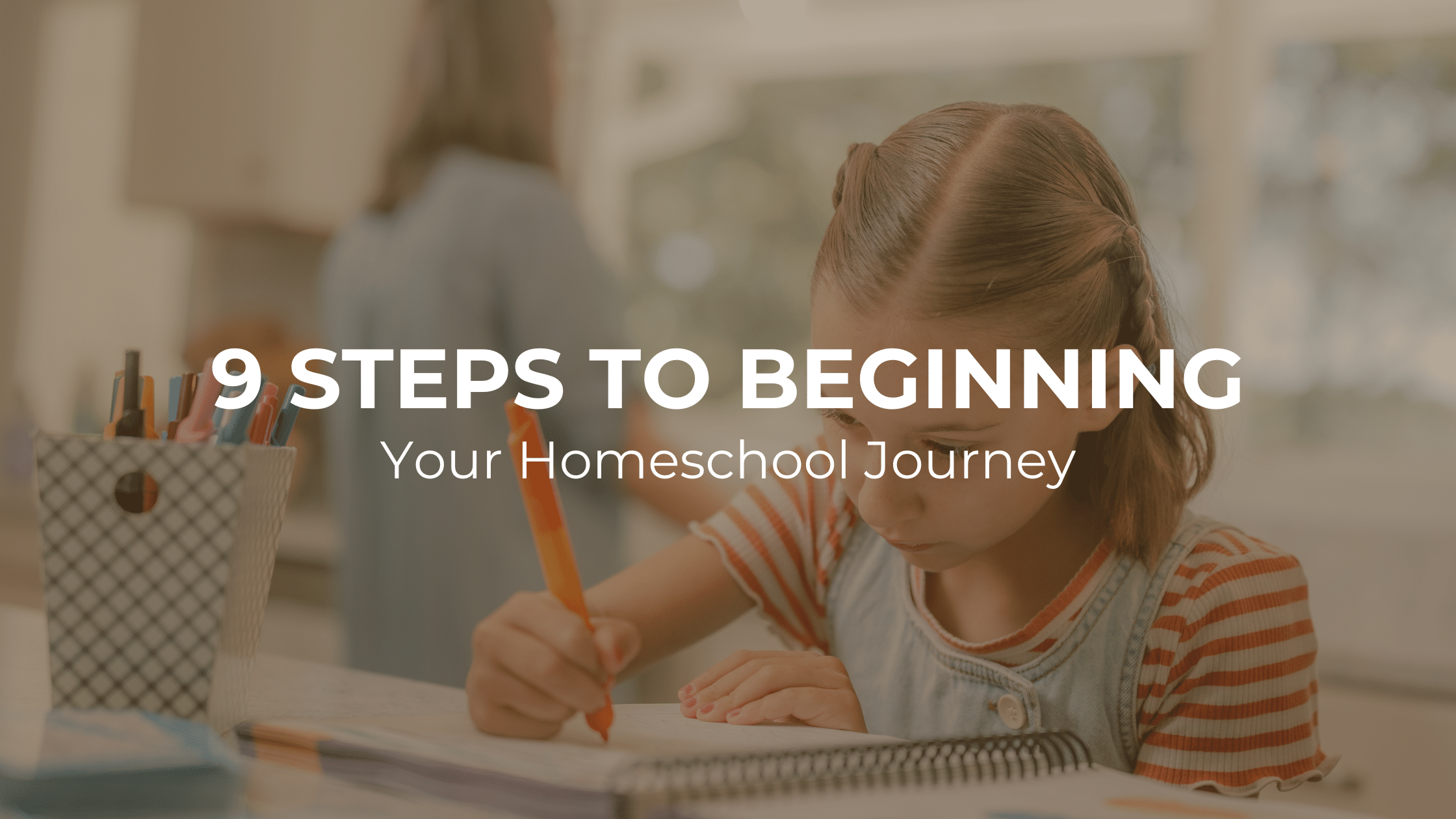
9 Steps to Begin Your Homeschool Journey
So, you feel called to homeschool, but you don’t know how to begin your homeschool journey? It’s a daunting task—educating your children while raising them to be responsible, kind, productive, God-fearing individuals. But God designed and prepared you perfectly for this role, and where you may be lacking, God fills in the gaps. Here are a few tips on how to begin this adventure of a lifetime.
Step 1: Pray and then Pray Some More

Step 2: Research Your State’s Requirements
The next step is to make sure you understand the legal requirements within your state and/or country. Homeschooling is legal in every US state, but each state has specific requirements regarding reporting and proving that you are, in fact, educating your student(s). Many states even require specific courses, particularly for older students. The Homeschool Legal Defense Association is an excellent resource for this information.
Step 3: Watch our Apologia Homeschool Bootcamp Series
Once you’ve done your research on the legalities regarding homeschooling, we would highly recommend watching our 12-part video series, Homeschool Bootcamp. Each video includes a discussion with homeschool veterans about one of the following topics:
1. History of Homeschool: The Modern Movement
Join Davis Carman and Ladd Lesh as they discuss the journey of our educational structure through the years.
2. Why Should I Choose to Homeschool? Discover the Joys and Benefits of Home Education
Join Davis and Rachael Carman and Ladd and April Lesh as they discuss the many benefits of homeschooling.
3. Practical Tips from the Trenches
Davis and Rachael Carman, homeschool veterans of seven children, and Ladd and April Lesh, homeschooling parents of nine, provide practical tips for the day-to-day homeschooling life.
4. Learning Challenges: Embracing Differences, Adapting Resources, and Overcoming Obstacles
Katie Waalkes, of Life in the Mundane, shares how her family handles homeschooling children with various special needs.
5. How to Homeschool as a Working Parent
Carrie Henry, a working homeschool mom of triplets, shares her story of God’s provision in her life and in her children’s home education journey.
6. How to Homeschool Through High School: Transcripts & Graduating with Humility & Grace
Davis and Rachael Carman, homeschool veterans, share their insights on homeschooling through the high school years.
7. How to Homeschool as a Single Parent: Finding Support and Embracing Flexibility
Nicki Truesdell, author of “Anyone Can Homeschool,” shares her experience homeschooling her children as a single parent.
8. What About Socialization? Developing Positive Relationships and Social Skills While Homeschooling
Davis and Rachael Carman, homeschooling veterans of seven, share their insights and tips on tackling the popular question, “What about socialization?”
9. Choosing a Homeschool Curriculum that Works: Discovering How Your Child Learns Best
Ladd and April Lesh, homeschool parents of nine, share their tips on selecting the best curricula for your students.
10. Homeschool Planning and Goal Setting: Strategic Planning for a Purposeful Homeschool Journey
Rachael Carman, a former homeschooling mom of seven, and April Lesh, a homeschooling mom of nine, share their tips on setting goals for your family’s homeschool.
11. Breaking Free of a Public School Mindset: Embracing Freedom Beyond the Conventional School Paradigm
Davis and Rachael Carman discuss ways to adjust your mindset as a homeschooling parent from previous public school experiences.
12. Homeschool: A Day in the Life: Cultivating Rhythms & Balance in Your Home
Rachael Carman and April Lesh share their experience as homeschooling mothers on cultivating daily rhythms and balance in your home.
Step 4: Gather Tips from Other Parents
After gathering tips online, try to find other homeschooling parents in your community and pick their brains. Make a coffee date (or play date) with a homeschool mom you already know, ask questions, and take notes as you fellowship. Not only will this help you in preparing to homeschool, but it will also set you up for success by providing you with a community of parents going through the same journey.
If you’re not sure where to find local homeschooling parents, here are some great places to look:
- Sign Up for a Co-op
- This works great if you’re ready to dive headfirst into homeschooling while having your student take a few classes at a local co-op.
- Use Social Media
- There are dozens of Facebook Groups for homeschooling parents. MeetUp is also an excellent resource for meeting people with similar mindsets or interests. Nextdoor is perfect for finding people in your neighborhood.
- Ask Around at Church
- In the Christian community, chances are, even if you don’t know someone who homeschools, someone you know does. Make sure people know you are looking!
Step 5: Study Your Children

Learning Styles
- Visual
- Visual learners respond best to graphics, videos, etc.
- Auditory
- Auditory learners respond best to audiobooks, lectures, etc.
- Independent
- Independent learners typically respond best to reading and writing.
- Social
- Social learners learn best by interacting with others.
Interests
If your student likes learning about animals, pick up one of our Exploring Creation with Zoology curriculums and plan a trip to the zoo or aquarium. If they enjoy space, order Exploring Creation with Astronomy and schedule an outing to your local planetarium or sit out under the stars in your backyard. If they like history, rent some documentaries and take a drive to a local historical destination or museum. If they are into art, incorporate drawing in their science, history, and English courses. Have them draw a picture of a bird they saw outside, or of a Founding Father, or of what they imagine a character in a book they’re reading looks like. The possibilities are endless, and your student will continue to enjoy their education if you lean into their interests.
Step 6: Determine Your Top 3 Goals as a Family and a Homeschool
When you begin any new adventure, it’s important to recognize what success in that area will look like for you so you can set goals to help you achieve that. We all need a direction to aim towards. Homeschooling is no different. Take some time to stop and think about your family, your faith, and what your family values most. With these concepts in mind, determine the priorities you want to set for your family and your homeschool.
Step 7: Research Curriculum
Now it’s time to start looking for a curriculum. These days, there are many great curriculums to choose from. This is a great problem to have, but it can make it difficult to narrow it down to what is best for you and your family.
A great place to start is figuring out the best homeschooling method for your family’s culture and child’s learning style.
- Charlotte Mason—The Charlotte Mason method intertwines aspects of nature study and journaling, hands-on learning, and living books (or books written directly to the student) with a God-focused style of learning. Apologia’s curriculum follows the Charlotte Mason method.
Other homeschool learning methods include:
- Montessori—This method incorporates a lot of hands-on activities with students of multiple ages, learning together and teaching each other. The atmosphere has routine but is relaxed and reflects a learning environment.
- Unschooling—This method doesn’t include any formal curriculum, schedule, or testing. It is a fully self-directed education.
- Traditional—This method is the closest to a typical classroom. Students have a schedule and a classroom environment at home while the parent acts as the teacher.
- Unit Studies—This method involves choosing a topic and incorporating all subjects into it.
- For example, if your student is interested in land animals, you could study zoology for science, the story of Noah for Bible, read Little Pilgrim’s Progress for English, draw pictures of animals your students see in your yard for art, study the locations in which certain animals live for geography, and use word problems surrounding animals for mathematics.
- Classical—This method is an old one that follows a three-step learning approach. The early years are all about absorbing facts, the middle years focus on learning to think, while the teen years are about learning to express one’s thoughts. This method involves a strict schedule and a lot of reading, memorization, and Socratic seminars.
Step 8: Make a Schedule That Makes Sense for Your Family, and Don’t Be Afraid to Change It Up
One family’s homeschool routine is not going to look the same as another’s, and that’s okay! Plan something that will work with your family’s schedule. If you have a husband who wants to teach a couple of subjects but works 24-hour shifts, try a form of block scheduling. If your family has activities in the morning, do school in the afternoon. If your family travels a lot, do school on the go. There is no one right way to homeschool. Find what works for your family and stick with it! If your initial plan doesn’t seem to work for you, try something else!
Step 9: Stock Up on Supplies & Get Organized
Setting the stage for a great learning environment might take more than stocking up on colored pencils—although that is important! It may take some rearranging after the school year begins or even after a couple of school years, but set your family up for success by decorating an inviting learning space and by placing the supplies in easy-to-reach places! Find more great homeschool classroom organization tips in this blog post!




